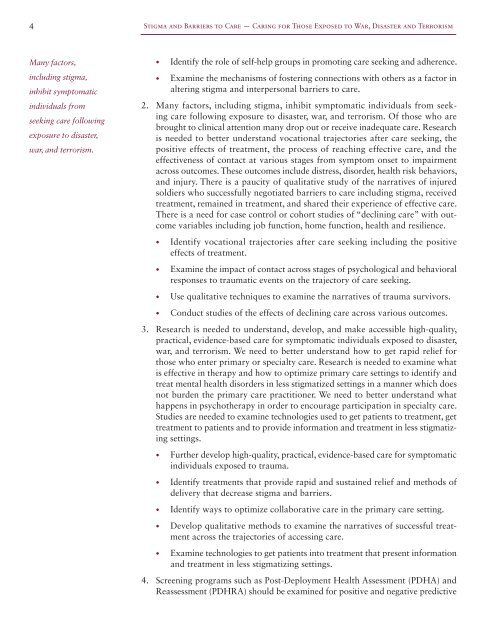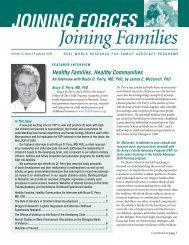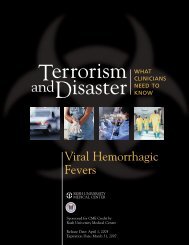stigma and barriers to care - Uniformed Services University of the ...
stigma and barriers to care - Uniformed Services University of the ...
stigma and barriers to care - Uniformed Services University of the ...
Create successful ePaper yourself
Turn your PDF publications into a flip-book with our unique Google optimized e-Paper software.
4<br />
Stigma <strong>and</strong> Barriers <strong>to</strong> Care — Caring for Those Exposed <strong>to</strong> War, Disaster <strong>and</strong> Terrorism<br />
Many fac<strong>to</strong>rs,<br />
including <strong>stigma</strong>,<br />
inhibit symp<strong>to</strong>matic<br />
individuals from<br />
seeking <strong>care</strong> following<br />
exposure <strong>to</strong> disaster,<br />
war, <strong>and</strong> terrorism.<br />
••<br />
Identify <strong>the</strong> role <strong>of</strong> self-help groups in promoting <strong>care</strong> seeking <strong>and</strong> adherence.<br />
••<br />
Examine <strong>the</strong> mechanisms <strong>of</strong> fostering connections with o<strong>the</strong>rs as a fac<strong>to</strong>r in<br />
altering <strong>stigma</strong> <strong>and</strong> interpersonal <strong>barriers</strong> <strong>to</strong> <strong>care</strong>.<br />
2. Many fac<strong>to</strong>rs, including <strong>stigma</strong>, inhibit symp<strong>to</strong>matic individuals from seeking<br />
<strong>care</strong> following exposure <strong>to</strong> disaster, war, <strong>and</strong> terrorism. Of those who are<br />
brought <strong>to</strong> clinical attention many drop out or receive inadequate <strong>care</strong>. Research<br />
is needed <strong>to</strong> better underst<strong>and</strong> vocational trajec<strong>to</strong>ries after <strong>care</strong> seeking, <strong>the</strong><br />
positive effects <strong>of</strong> treatment, <strong>the</strong> process <strong>of</strong> reaching effective <strong>care</strong>, <strong>and</strong> <strong>the</strong><br />
effectiveness <strong>of</strong> contact at various stages from symp<strong>to</strong>m onset <strong>to</strong> impairment<br />
across outcomes. These outcomes include distress, disorder, health risk behaviors,<br />
<strong>and</strong> injury. There is a paucity <strong>of</strong> qualitative study <strong>of</strong> <strong>the</strong> narratives <strong>of</strong> injured<br />
soldiers who successfully negotiated <strong>barriers</strong> <strong>to</strong> <strong>care</strong> including <strong>stigma</strong>, received<br />
treatment, remained in treatment, <strong>and</strong> shared <strong>the</strong>ir experience <strong>of</strong> effective <strong>care</strong>.<br />
There is a need for case control or cohort studies <strong>of</strong> “declining <strong>care</strong>” with outcome<br />
variables including job function, home function, health <strong>and</strong> resilience.<br />
••<br />
Identify vocational trajec<strong>to</strong>ries after <strong>care</strong> seeking including <strong>the</strong> positive<br />
effects <strong>of</strong> treatment.<br />
••<br />
Examine <strong>the</strong> impact <strong>of</strong> contact across stages <strong>of</strong> psychological <strong>and</strong> behavioral<br />
responses <strong>to</strong> traumatic events on <strong>the</strong> trajec<strong>to</strong>ry <strong>of</strong> <strong>care</strong> seeking.<br />
••<br />
Use qualitative techniques <strong>to</strong> examine <strong>the</strong> narratives <strong>of</strong> trauma survivors.<br />
••<br />
Conduct studies <strong>of</strong> <strong>the</strong> effects <strong>of</strong> declining <strong>care</strong> across various outcomes.<br />
3. Research is needed <strong>to</strong> underst<strong>and</strong>, develop, <strong>and</strong> make accessible high-quality,<br />
practical, evidence-based <strong>care</strong> for symp<strong>to</strong>matic individuals exposed <strong>to</strong> disaster,<br />
war, <strong>and</strong> terrorism. We need <strong>to</strong> better underst<strong>and</strong> how <strong>to</strong> get rapid relief for<br />
those who enter primary or specialty <strong>care</strong>. Research is needed <strong>to</strong> examine what<br />
is effective in <strong>the</strong>rapy <strong>and</strong> how <strong>to</strong> optimize primary <strong>care</strong> settings <strong>to</strong> identify <strong>and</strong><br />
treat mental health disorders in less <strong>stigma</strong>tized settings in a manner which does<br />
not burden <strong>the</strong> primary <strong>care</strong> practitioner. We need <strong>to</strong> better underst<strong>and</strong> what<br />
happens in psycho<strong>the</strong>rapy in order <strong>to</strong> encourage participation in specialty <strong>care</strong>.<br />
Studies are needed <strong>to</strong> examine technologies used <strong>to</strong> get patients <strong>to</strong> treatment, get<br />
treatment <strong>to</strong> patients <strong>and</strong> <strong>to</strong> provide information <strong>and</strong> treatment in less <strong>stigma</strong>tizing<br />
settings.<br />
••<br />
Fur<strong>the</strong>r develop high-quality, practical, evidence-based <strong>care</strong> for symp<strong>to</strong>matic<br />
individuals exposed <strong>to</strong> trauma.<br />
••<br />
Identify treatments that provide rapid <strong>and</strong> sustained relief <strong>and</strong> methods <strong>of</strong><br />
delivery that decrease <strong>stigma</strong> <strong>and</strong> <strong>barriers</strong>.<br />
••<br />
Identify ways <strong>to</strong> optimize collaborative <strong>care</strong> in <strong>the</strong> primary <strong>care</strong> setting.<br />
••<br />
Develop qualitative methods <strong>to</strong> examine <strong>the</strong> narratives <strong>of</strong> successful treatment<br />
across <strong>the</strong> trajec<strong>to</strong>ries <strong>of</strong> accessing <strong>care</strong>.<br />
••<br />
Examine technologies <strong>to</strong> get patients in<strong>to</strong> treatment that present information<br />
<strong>and</strong> treatment in less <strong>stigma</strong>tizing settings.<br />
4. Screening programs such as Post-Deployment Health Assessment (PDHA) <strong>and</strong><br />
Reassessment (PDHRA) should be examined for positive <strong>and</strong> negative predictive




